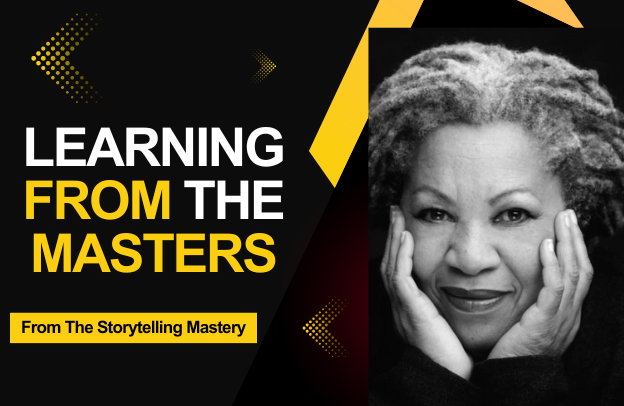7 Key Business Storytelling Strategies From Steve Jobs

Steven Paul Jobs was a renowned American entrepreneur, innovator, and investor, who achieved widespread recognition as the co-founder of Apple Inc. Jobs played a pivotal role as the founder of NeXT and he held the positions of chairman and majority shareholder at Pixar.
Want to learn more about storytelling? Start by downloading the first chapter of The Storytelling Mastery.
Above all, Steve Jobs was a master storyteller, and his ability to communicate effectively played a significant role in Apple’s success. That is what we are going to be reflecting upon in today’s video and learning new ways to apply the same principles in our business narratives.
Who was Steven Paul Jobs?
Steven Paul Jobs, widely known as Steve Jobs, was an American business magnate, inventor, and visionary who co-founded Apple Inc. in 1976. Born on February 24, 1955, in San Francisco, California, Jobs played a pivotal role in revolutionizing the technology and entertainment industries. His relentless pursuit of innovation led to the development of iconic products such as the Apple Macintosh, iPod, iPhone, and iPad.
Jobs was not only a brilliant entrepreneur but also a charismatic and influential leader who had a profound impact on design aesthetics and user experience. His ability to anticipate and shape consumer desires, coupled with his emphasis on simplicity and elegance in product design, solidified Apple’s position as a global technology giant.
Read more about the series – Learning From The Master
Despite facing setbacks and being ousted from Apple in the 1980s, Jobs later returned to the company and orchestrated its remarkable turnaround. His leadership style was characterized by a commitment to perfection, a focus on creating transformative products, and an uncompromising attitude toward quality.
Steve Jobs passed away on October 5, 2011, leaving behind a lasting legacy as one of the most influential figures in the tech industry, revered for his innovative spirit, design sensibility, and the enduring impact of his contributions on the way we live and interact with technology.
7 Key Business Storytelling Strategies From Steve Jobs
Here are the seven key storytelling strategies that businesses can learn from Steve Jobs:
1. Clarity and simplification
Steve Jobs was known for simplifying complex concepts to make them accessible to a broader audience. In his product launches, he always focused on a few key features, making the message clear and easy to understand. Businesses can apply this strategy by distilling their message to its essence and avoiding unnecessary jargon.
Remember, for example, Apple’s “Think Different” campaign, where Jobs emphasized simplicity in design and functionality.
2. Create a Compelling Narrative
Jobs didn’t just present products; he told compelling stories that captivated the audience. He often framed Apple’s products as tools to empower individuals and change the world, thereby reinforcing the idea of a bigger mission of the company.
Similarly, businesses can learn to create a narrative around their products or services, emphasizing their impact on customers’ lives.
In the introduction of the iPod in 2001, Jobs positioned it as a device to carry “a thousand songs in your pocket,” telling a story about music lovers and their experiences. Can you think of your business and how you can do the same?
3. Visual Storytelling
Jobs was a master at using visuals to enhance his storytelling. Apple’s presentations were known for their clean and minimalistic slides. Businesses can benefit by incorporating visually compelling elements into their presentations and marketing materials.
In the iconic iPhone introduction in 2007, Jobs specifically leveraged the power of visuals to showcase the device’s features and design and it was effective.
4. Engage the Audience
Jobs knew how to engage his audience through charisma, enthusiasm, and a personal connection. Businesses should focus on building a connection with their audience, understanding their needs, and addressing them directly in their storytelling.
Jobs was particularly known for this in his keynote presentations, where he engaged the audience with rhetorical questions, humor, and relatable anecdotes. Can you apply the same in your business? I think you should.
5. Demonstrate Passion
Passion was a hallmark of Jobs’ presentations. His enthusiasm for Apple’s products was contagious. Businesses should convey genuine passion for their products or services, inspiring confidence, and excitement among customers.
Is there any example? Do you remember Jobs’ enthusiasm during the launch of the original iPhone in 2007? That was a powerful presentation where he conveyed his belief that it would revolutionize the industry. I think the message is clear, even several years later.
6. Addressing Customer Needs
Jobs had a deep understanding of customer needs and pain points. He positioned Apple products as solutions to these needs. Businesses should focus on understanding their customers and demonstrating how their offerings meet specific requirements.
Think of how Jobs addressed the need for a simplified and integrated user experience in the introduction of the iPhone.
7. The Power Of Secrecy And Surprise
Yes, you heard me right. Apple under Jobs was known for keeping its projects under wraps until the big reveal. This strategy built anticipation and excitement. Businesses can generate interest and curiosity by maintaining an element of surprise in their storytelling and product launches.
If you are looking for a better suspect, consider the secrecy surrounding the development of the original iPhone, leading to a groundbreaking announcement in 2007.
To learn more, see also 6 Key Business Storytelling Strategies From Elon Musk.
Steve Jobs’s contribution to business storytelling
Steve Jobs made significant contributions to the art of business storytelling through his charismatic presentations and product launches. Jobs was a master storyteller, known for his captivating and theatrical keynote addresses that unveiled Apple’s latest innovations.
He had an unparalleled ability to distill complex technological concepts into compelling narratives that resonated with audiences. Jobs understood the power of storytelling in conveying the essence and value of a product, turning product launches into memorable events that captured the imagination of consumers and the media alike.
One key aspect of Jobs’ storytelling was his focus on emotional connection. He didn’t just present features and specifications; he framed Apple’s products within a broader narrative that emphasized how they would enhance and simplify users’ lives.
By crafting a narrative around each product, he transformed the marketing and communication strategy in the tech industry, emphasizing the user experience and the emotional impact of technology.
Steve Jobs’ approach to business storytelling has since become a benchmark for effective communication in the corporate world, inspiring leaders to not only sell products but to tell compelling stories that resonate with their audience and create lasting connections.
Conclusion on 7 Key Business Storytelling Strategies From Steve Jobs
Incorporating these storytelling strategies into business presentations, marketing campaigns, and product launches can help create a more impactful and memorable narrative.
If you execute this well just as Steve Jobs did throughout his career at Apple, you can take your business to the next level, leveraging the power of storytelling.
Did you find any value in this presentation? Please, let us know in the comment section below and share the video also with your friends who might like it.
To learn more, join our storytelling mastery for businesses at Academy.aclasses.org/storytellingmastery.






